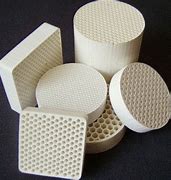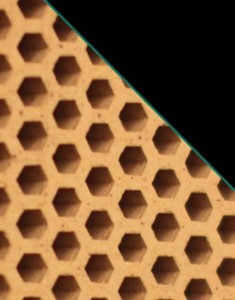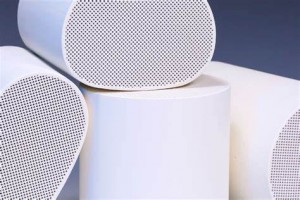As a functional porous material, honeycomb ceramic is a new type of structural ceramic product, named for its internal structure similar to the shape of a honeycomb. The evenly distributed honeycomb cross-sectional shape can be divided into hexagonal, square, triangular, circular and other geometric figures.
Honeycomb ceramic substrate is the core component in the aftertreatment system of automobile exhaust gas. Honeycomb ceramics used to carry coated catalysts or capture particulate matter in exhaust gas aftertreatment systems of internal combustion engines are called honeycomb ceramic carriers. After coating the catalyst, the honeycomb ceramic carrier is packaged and integrated into the exhaust after-treatment system of the internal combustion engine, and assembled on the vehicle along with the internal combustion engine.
In the 1970s, Corning Corporation of the United States invented cordierite honeycomb ceramics as a carrier coated with exhaust gas aftertreatment catalysts, providing an efficient reaction center for exhaust gas aftertreatment chemical reactions. The automobile exhaust after-treatment system is gradually developed with the honeycomb ceramic carrier as the core.
According to the different ways of exhaust gas flow, honeycomb ceramic substrates are mainly divided into straight-through substrates and wall-flow substrates. Among them, straight-through carriers mainly include SCR carriers, DOC carriers, ASC carriers, and TWC carriers; wall-flow carriers mainly include DPF and GPF. Among the above carriers, TWC carrier and GPF are used for gasoline vehicles, and SCR carrier, DOC carrier, ASC carrier and DPF are used for diesel vehicles.
Because honeycomb ceramic products have many parallel flow channels, the pressure loss of gas circulation is small, and the flow distribution in the whole component is good. In addition, the thin-walled network structure of honeycomb ceramics makes them light in weight, high in strength and large in surface area, and are widely used. Used in heat exchangers, radiators, catalyst carriers, sound insulation materials, etc.
Because honeycomb ceramics have the characteristics of large surface area, good heat insulation, light weight, low thermal expansion coefficient, high temperature resistance, acid and alkali resistance, etc., they are widely used in automobile exhaust treatment, flue gas purification, heat storage, infrared Radiation combustion board, setter board of powder metallurgy, carrier and catalyst of chemical reaction, heat insulation material of kiln, etc. In recent years, with the continuous development of the preparation process, its application range has been continuously expanded. Honeycomb ceramics can be made of a variety of materials, the main materials are cordierite, mullite, silicon carbide, zirconia, silicon nitride and cordierite-mullite composite matrix. The industry generally chooses high-quality kaolin, talc, alumina and other synthetic cordierite honeycomb ceramics.
Cordierite ceramic supports can be used at a temperature of about 1300°C. Coupled with the high-density honeycomb structure (400 holes per square inch) and the geometric shape of ultra-thin wall thickness (0.15mm), the carrier has a large geometric surface area, exhaust gas limit, chemical properties, and rapid temperature rise. Therefore, , it becomes our ideal catalyst carrier.
Post time: Jan-16-2023










